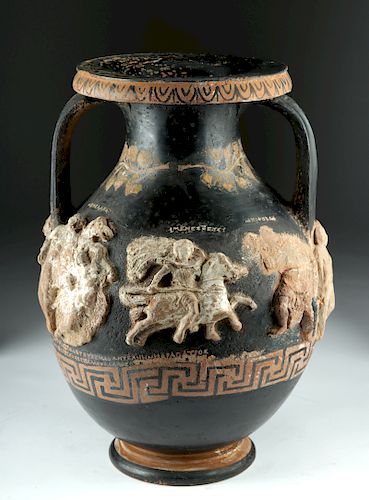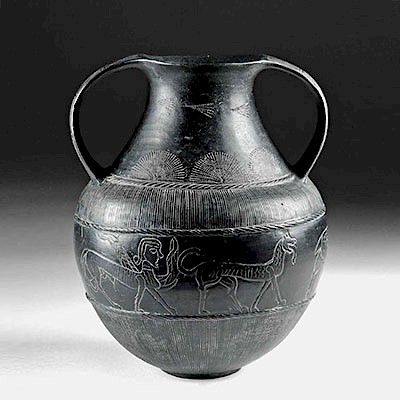Attic Red Figure Pelike w/ Reliefs & Iliad Inscriptions
Lot 22a
About Seller
Artemis Fine Arts
686 S Taylor Ave, Ste 106
Louisville, CO 80027
United States
Selling antiquities, ancient and ethnographic art online since 1993, Artemis Gallery specializes in Classical Antiquities (Egyptian, Greek, Roman, Near Eastern), Asian, Pre-Columbian, African / Tribal / Oceanographic art. Our extensive inventory includes pottery, stone, metal, wood, glass and textil...Read more
Estimate:
$60,000 - $80,000
Absentee vs Live bid
Two ways to bid:
- Leave a max absentee bid and the platform will bid on your behalf up to your maximum bid during the live auction.
- Bid live during the auction and your bids will be submitted real-time to the auctioneer.
Bid Increments
| Price | Bid Increment |
|---|---|
| $0 | $25 |
| $300 | $50 |
| $1,000 | $100 |
| $2,000 | $250 |
| $5,000 | $500 |
| $10,000 | $1,000 |
| $20,000 | $2,500 |
| $50,000 | $5,000 |
| $100,000 | $10,000 |
| $200,000 | $20,000 |
About Auction
By Artemis Fine Arts
Mar 21, 2019
Set Reminder
2019-03-21 10:00:00
2019-03-21 10:00:00
America/New_York
Bidsquare
Bidsquare : Fine Ancient | Asian | Ethnographic Art
https://www.bidsquare.com/auctions/artemis-gallery/fine-ancient-asian-ethnographic-art-3967
Featuring classical antiquities, ancient and ethnographic art from cultures encompassing the globe, plus fine art. Egyptian, Greek, Roman, Etruscan, Near Eastern, Asian, Pre-Columbian, Native American, African / Tribal, Oceanic, Spanish Colonial, Russian, Fine Art, so much more! Artemis Fine Arts info@artemisgallery.com
Featuring classical antiquities, ancient and ethnographic art from cultures encompassing the globe, plus fine art. Egyptian, Greek, Roman, Etruscan, Near Eastern, Asian, Pre-Columbian, Native American, African / Tribal, Oceanic, Spanish Colonial, Russian, Fine Art, so much more! Artemis Fine Arts info@artemisgallery.com
- Lot Description
Ancient Greece, Athens (Attic), ca. 4th century BCE. An attic, red-figure pelike with relief decoration and inscriptions naming characters from Homer's the Iliad. The almost spherical body, resting on a molded foot in two degrees with a reserved band around the top, merges gracefully into a concave neck with an overhanging rim, whose reserved hand has a black painted egg and dart motif. Thick strap handles with two vertical ribs connect the shoulders to the neck, which is decorated with two ivy vines with traces of yellow pigment. The main decoration, set above a broad meander band, consists of six applied relief figures, three on each side, with two more at the bases of the handles. These figures have been modeled separately and then attached to the black glazed surface of the pelike. Greek names are incised above the figures, some letters having white pigment still adhering, and there is a long inscription between the figures and the meander band on the side where the stem ends of the ivy meet on the neck. Size: 15.75" H (40 cm)
On the side with the long lower inscription, the leftmost figural group, labeled above with the name Menelaos, consists of a bearded man wearing a short belted chiton and high-topped boots stepping right onto the buttock of a woman falling right, her arms raised in supplication. She is nude except for drapery around her lower body. Both figures substantially cover a horse galloping to the right behind them. In the center of this side is a male figure riding right with a spear in his right hand, labeled above with the name Menestheus. The youth wears a finely pleated chiton, high-topped boots, and a cloak that billows out behind. At the right, the figure is substantially lost but probably male and is labeled Deiphosbos. He lunges left, with that leg extended behind, and wears what appears to be a cuirass over a short chiton, high-topped boots, and a cloak that billows around him. Below the handle is the restored figure of a nude youth striding left, based on the one at the base of the other handle. The young man turns his head back and down and carries a somewhat cylindrical object in his left hand. He wears a baldric diagonally across his chest, high-topped boots, and a cloak that billows behind.
On the side lacking a lower inscription, the relief figures are substantially more fragmentary. At the left was a group, now reduced to the greater part of one nude male who moves vigorously to the right, his left thigh held horizontally and with his shield on that arm. Above are two inscriptions, Polyxena (over his head) and Teukros (over the lost portion). In the center is a figure labeled Ajas (Ajax) who moves to the left and seems to wear a long-plumed helmet and a short tunic. Part of another leg, perhaps greeved, extends diagonally at the level of his left knee. At the right is a figure labeled Teiresias who is galloping right, a spear behind. Finally there is the handle figure of a nude youth striding left.
The names are those of characters from the Trojan War, but they do not seem to identify the relief figures, at least as they are in their present state on the vase. Menelaos was the brother of Agamemnon and the husband of Helen. Although he defeated Paris, he was depicted as a more "gentle" warrior (Iliad 3.340-382; 17.588). Menestheus was the leader of the Athenian forces in the Iliad. Delphobos, the son of Priam, was one of the most powerful Trojan warriors. He married Helen after Paris was killed, and was in turn killed by Menelaos. Polyxena, the daughter of Priam, was mortally wounded by Diomedes and Odysseus in the Cypria but was sacrificed on the tomb of Achilles in the Iliu Persis. Teukros was an excellent archer and the half-brother of Ajax, the great Greek warrior after Achilles. In the Little Iliad, the arms of Achilles went to Odysseus instead of Ajax, causing him to madly slaughter herds of the Greeks. Teiresias was the legendary seer whose ghost was consulted by Odysseus. The long inscription begins with the word hippodromos or hippodromoi, meaning either race course(s) or a light horseman/horsemen, and other words seem to refer to Mt. Athos and to someone's handiwork. Although in its present state it is quite difficult to decipher, it may be a dedication of some sort.
In the late 4th century BCE, Attic vase painting explored coloristic effects, particularly on a group of so-called Kerch Style vases, named for the locally near ancient Pantikapaion where many of these vessels have been found. These vases were exported from Attica not only to the Black Sea area, but to other sites ringing the Mediterranean, including northern Greece, southern Italy, France, Spain, North Africa, Egypt, the Levant, and Ionia. The style features the use of white, red, yellow, and blue pigments as well as gilding, and emphasized modeled figures, either through pictorial effects or applied reliefs. The vases with relief decoration apparently had more limited popularity, as there are fewer surviving examples. Most of these are small shapes, often lekythois, but a few large and spectacular pieces, such as this one, are known. The red clay figures on these vessels were typically made separately in molds, then applied to the black glazed background with clay slip as a bonding agent and finally painted and perhaps gilded. The vases with this kind of decoration were undoubtedly inspired by metallic relief vessels. At first only selected objects, such as shields or wreaths, were rendered in relief, but then a few figures were so accented, and finally whole scenes. The technique developed further into the reliefware that became quite popular from the Hellenistic period into Roman times.
Perhaps the closest parallel to this pelike is a relief squat lekythos in the Hermitage, inv. P. 1837.2, which is decorated with a scene of Persians hunting and has their names inscribed with added white paint. For an illustration, see Boris Piotrovsky, ed., The Hermitage (Leningrad, 1987), cat. No. 58, pp. 86-87. For a gilded hydria with a scene of the Calydonian boar hunt in similarly high relief, found at Lampsacus and now in the Istanbul Archaeological Museum, inv. 2922, see S. Reinach, in Mon. Piot 10 (1903), pp. 39-47, pl. 6. (The Anatolian Civilisations, (Istanbul, 1983) cat. No. B. 168, p. 72 & color pl. between pp. 12 & 13 in Land of Civilizations, Turkey (Japan 1985) cat. No. 219; Treasures from Turkey (Leiden, 1985), cat. No. 208, p. 147, Beryl Barr-Sharrar, The Derveni Krater (Princeton, 2008), fig. 79, p. 88). For discussion of this technique, see most recently, Beth Cohen, ed. The Colors of Clay (Malibu, 2006); see also E. Zervoudaki, "Attische polychrome Reliefkeramik" AM 83 (1968), pp. 1-88.
Provenance: private East Coast, USA collection; ex-William Froelich collection, New York, USA, acquired in the 1970s
All items legal to buy/sell under U.S. Statute covering cultural patrimony Code 2600, CHAPTER 14, and are guaranteed to be as described or your money back.
A Certificate of Authenticity will accompany all winning bids.
We ship worldwide and handle all shipping in-house for your convenience.
#139403Reassembled from multiple fragments with several areas of restoration and losses. Expected surface wear with abrasions and losses to red-figure, relief programs, and black ground commensurate with age. An incredibly rare example!Condition
- Shipping Info
-
All shipping is handled in-house for your convenience. Your invoice from Artemis Gallery will include shipping calculation instructions. If in doubt, please inquire BEFORE bidding for estimated shipping costs for individual items.
-
- Buyer's Premium



 EUR
EUR CAD
CAD AUD
AUD GBP
GBP MXN
MXN HKD
HKD CNY
CNY MYR
MYR SEK
SEK SGD
SGD CHF
CHF THB
THB











